Regulation of the Concentration Heterogeneity and Thermal Expansion Coefficient in the Metastable Invar FeNi31.1 Alloy
Abstract
1. Introduction
2. Materials and Methods
3. The Results of the Experiment
3.1. Mössbauer Spectroscopy of the FeNi31.1 Alloy
3.2. Development of the Austenite with the Concentration Heterogeneity during α→γ Transformation
3.3. The Relation between the TEC and Degree of Concentration Heterogeneity in the Austenite
4. Conclusions
Author Contributions
Funding
Institutional Review Board Statement
Informed Consent Statement
Data Availability Statement
Acknowledgments
Conflicts of Interest
References
- Nakamura, Y. The invar problem. IEEE Trans. Magn. 1976, 12, 278–291. [Google Scholar] [CrossRef]
- Van Schilfgaarde, M.; Abrikosov, I.A.; Johansson, B. Origin of the Invar effect in iron–nickel alloys. Nature 1999, 400, 46–49. [Google Scholar] [CrossRef]
- Ruban, A.V.; Katsnelson, M.I.; Olovsson, W.; Simak, S.I.; Abrikosov, I.A. Origin of magnetic frustrations in Fe−Ni Invar alloys. Phys. Rev. B 2005, 71, 054402. [Google Scholar] [CrossRef]
- Kim, G. Quantitative calculations of thermal-expansion coefficient in Fe–Ni alloys: First-principles approach. Curr. Appl. Phys. 2022, 38, 76–80. [Google Scholar] [CrossRef]
- Arai, J.; Nagata, S.; Shirasaki, M. Anomalous magnetic behaviors of Fe-Ni invar alloys deposited by sputtering. J. Magn. Magn. Mater. 1983, 31–34, 109–110. [Google Scholar] [CrossRef]
- Chamberod, A.; Laugier, J.; Penisson, J.M. Electron irradiation effects on iron-nickel invar alloys. J. Magn. Magn. Mater. 1979, 10, 139–144. [Google Scholar] [CrossRef]
- Kagawa, H.; Chikazumi, S. Origin of Δα-effect in Fe–Ni invar alloy. J. Phys. Soc. Jpn. 1977, 43, 1097–1098. [Google Scholar] [CrossRef]
- Tino, Y.; Nakaya, Y. On the phase mixtures produced by annealing of long duration in the γ-phase Fe–Ni invar alloys. J. Phys. Soc. Jpn. 1977, 41, 54–58. [Google Scholar] [CrossRef]
- Chikazumi, S.; Mizoguchi, T.; Yamaguchi, N. The Invar Problem. J. Appl. Phys. 1968, 39, 939–944. [Google Scholar] [CrossRef]
- Valiev, E.Z.; Menshikov, A.Z. Linear and nonlinear magnetoelastic interactions in the molecular field theory and invar anomalies. J. Magn. Magn. Mater. 1984, 46, 199–206. [Google Scholar] [CrossRef]
- Komura, S.; Takeda, T. A model of magnetic inhomogeneous structure for Fe-Ni invar alloys. J. Magn. Magn. Mater. 1979, 10, 191–193. [Google Scholar] [CrossRef]
- Chikazumi, S. Invar anomalies. J. Magn. Magn. Mater. 1979, 10, 113–119. [Google Scholar] [CrossRef]
- Al-Dabbagh, J.B.; Al-Faluji, I.K.; Hashim, Y.B. Thermal expansion in ferromagnetic Fe-Ni invar alloy. Int. J. Eng. Sci. 2012, 1, 48–51. [Google Scholar]
- Zheng, X.; Cahill, D.G.; Zhao, J.C. Effect of MeV ion irradiation on the coefficient of thermal expansion of Fe–Ni Invar alloys: A combinatorial study. Acta Mater. 2010, 58, 1236–1241. [Google Scholar] [CrossRef]
- Danilov, S.E.; Arbuzov, V.L.; Kazantsev, V.A. Phase separation of solid solution in Fe-Ni and Fe-Ni-P alloys during irradiation, deformation, and annealing. Phys. Met. Metallogr. 2014, 115, 126–133. [Google Scholar] [CrossRef]
- Shabashov, V.A.; Sagaradze, V.V.; Kozlov, K.A.; Ustyugov, Y.M. Atomic order and submicrostructure in iron alloys at megaplastic deformation. Metals 2018, 8, 995. [Google Scholar] [CrossRef]
- Shabashov, V.A.; Kozlov, K.A.; Sagaradze, V.V.; Nikolaev, A.L.; Lyashkov, K.A.; Semyonkin, V.A.; Voronin, V.I. Short-range order clustering in BCC Fe–Mn alloys induced by severe plastic deformation. Philos. Mag. 2018, 98, 560–576. [Google Scholar] [CrossRef]
- Shabashov, V.A.; Kozlov, K.A.; Zamatovskii, A.E.; Lyashkov, K.A.; Sagaradze, V.V.; Danilov, S.E. Short-range atomic ordering accelerated by severe plastic deformation in FCC invar Fe–Ni alloys. Phys. Met. Metallogr. 2019, 120, 686–693. [Google Scholar] [CrossRef]
- Sagaradze, V.V.; Danilchenko, V.E.; L’Heritier, P.; Shabashov, V.A. The structure and properties of Fe–Ni alloys with a nanocrystalline austenite formed under different conditions of γ–α–γ transformations. Mat. Sci. Eng. A 2002, 337, 146–159. [Google Scholar] [CrossRef]
- Yamamoto, T.; Nagayama, T.; Nakamura, T. Thermal expansion and thermal stress behavior of electroless-plated Fe–Ni–B alloy thin film for high-density packaging. J. Electrochem. Soc. 2019, 166, D3238. [Google Scholar] [CrossRef]
- Rusakov, V.S.; Kadyrzhanov, K.K. Mössbauer spectroscopy of locally inhomogeneous systems. Hyperfine Interact. 2005, 164, 87–97. [Google Scholar] [CrossRef]
- Crangle, J.; Hallam, G.C. The magnetization of face-centered cubic and body-centered cubic iron + nickel alloys. Proc. Roy. Soc. A 1963, 272, 119–132. [Google Scholar] [CrossRef]
- Van Der Woude, F.; Sawatzky, G.A. Mössbauer effect in iron and dilute iron based alloys. Phys. Rep. 1974, 12, 335–374. [Google Scholar] [CrossRef]
- Lauermanova, J. Effective magnetic fields in the Fe–Ni–C martensite. In Proceedings of the 5th International Conference on Moessbauer Spectroscopy, Bratislava, Czechoslovakia, 3–7 September 1973; Prague, Pt. 2, 1975. pp. 302–304. [Google Scholar]
- Shabashov, V.A.; Sagaradze, V.V.; Zamatovskii, A.E.; Kozlov, K.A.; Kataeva, N.V. Radiation-induced atomic redistribution in Aging Fe–Ni alloys upon neutron irradiation. Phys. Metals Metallogr. 2017, 118, 846–856. [Google Scholar] [CrossRef]
- Müller, J.B.; Hesse, J. A model for magnetic abnormalies of FeNi Invar alloys. Z. Für Phys. B Condens. Matter 1983, 54, 35–42. [Google Scholar] [CrossRef]
- Gonser, U.; Nasu, S.; Kappes, W. Mössbauer spectroscopy of Fe-Ni and Fe-Pt alloys. J. Magn. Magn. Mat. 1979, 10, 244–251. [Google Scholar] [CrossRef]
- Shabashov, V.A.; Sagaradze, V.V.; Zamatovskii, A.E.; Pilyugin, V.P.; Kozlov, K.A.; Litvinov, A.V.; Kataeva, N.V. Dynamic aging in an Fe–Ni–Al alloy upon megaplastic deformation. Effect of the temperature and deformation rate. Phys. Metals Metallogr. 2016, 117, 805–816. [Google Scholar] [CrossRef]
- Sagaradze, V.V.; Shabashov, V.A.; Lapina, T.M.; Arbuzov, V.L. Phase transformations during a low-temperature electron irradiation of Fe–Ni and Fe–Ni–Ti austenitic alloys. Phys. Metals Metallogr. 1994, 78, 414–419. [Google Scholar]
- Kubaschewski, O. Iron Binary Phase Diagrams; Springer: New York, NY, USA, 1982. [Google Scholar]
- Kaufman, L.; Cohen, M. The martensitic transformation in the iron-nickel system. JOM 1956, 8, 1393–1401. [Google Scholar] [CrossRef]
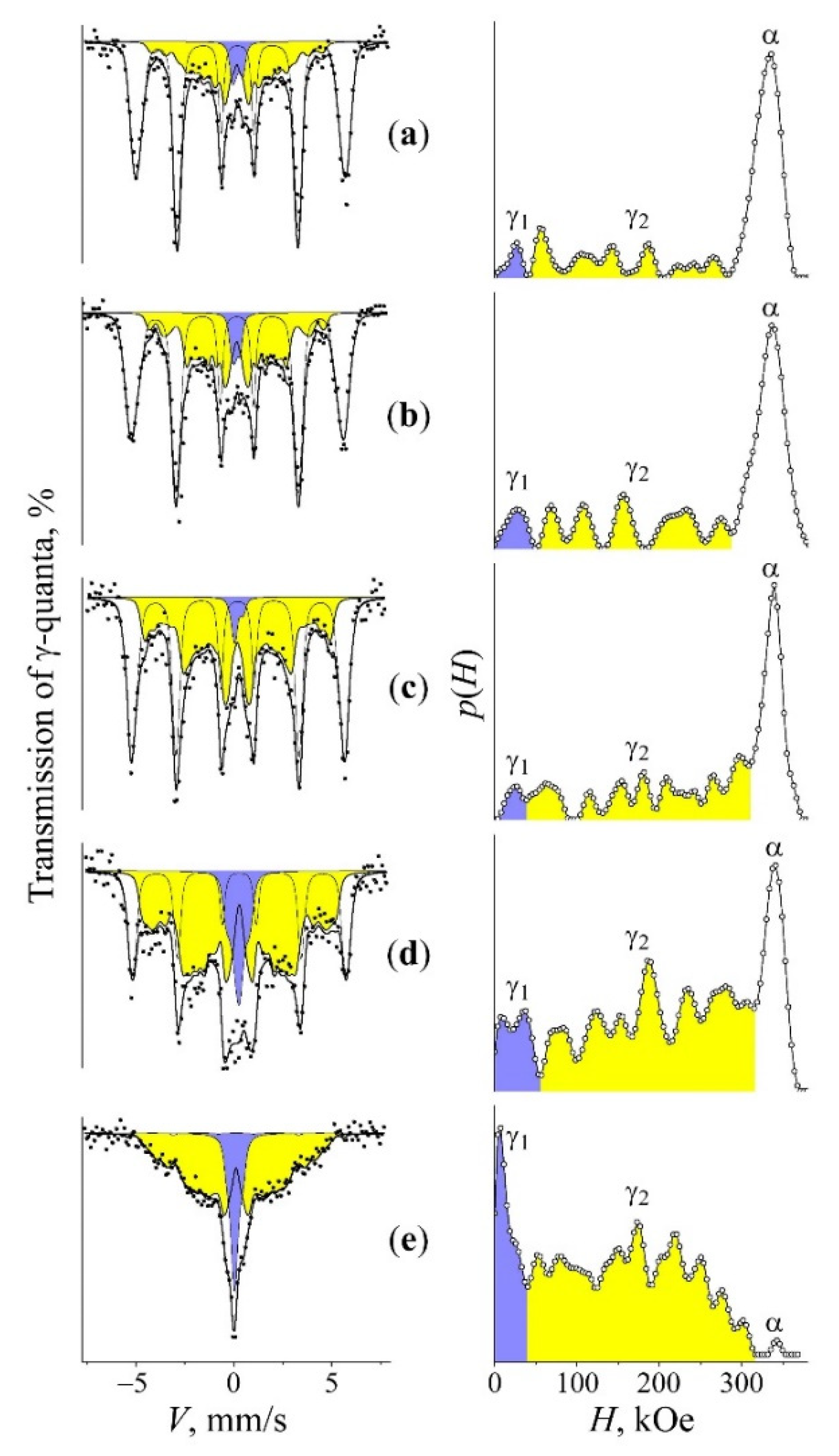
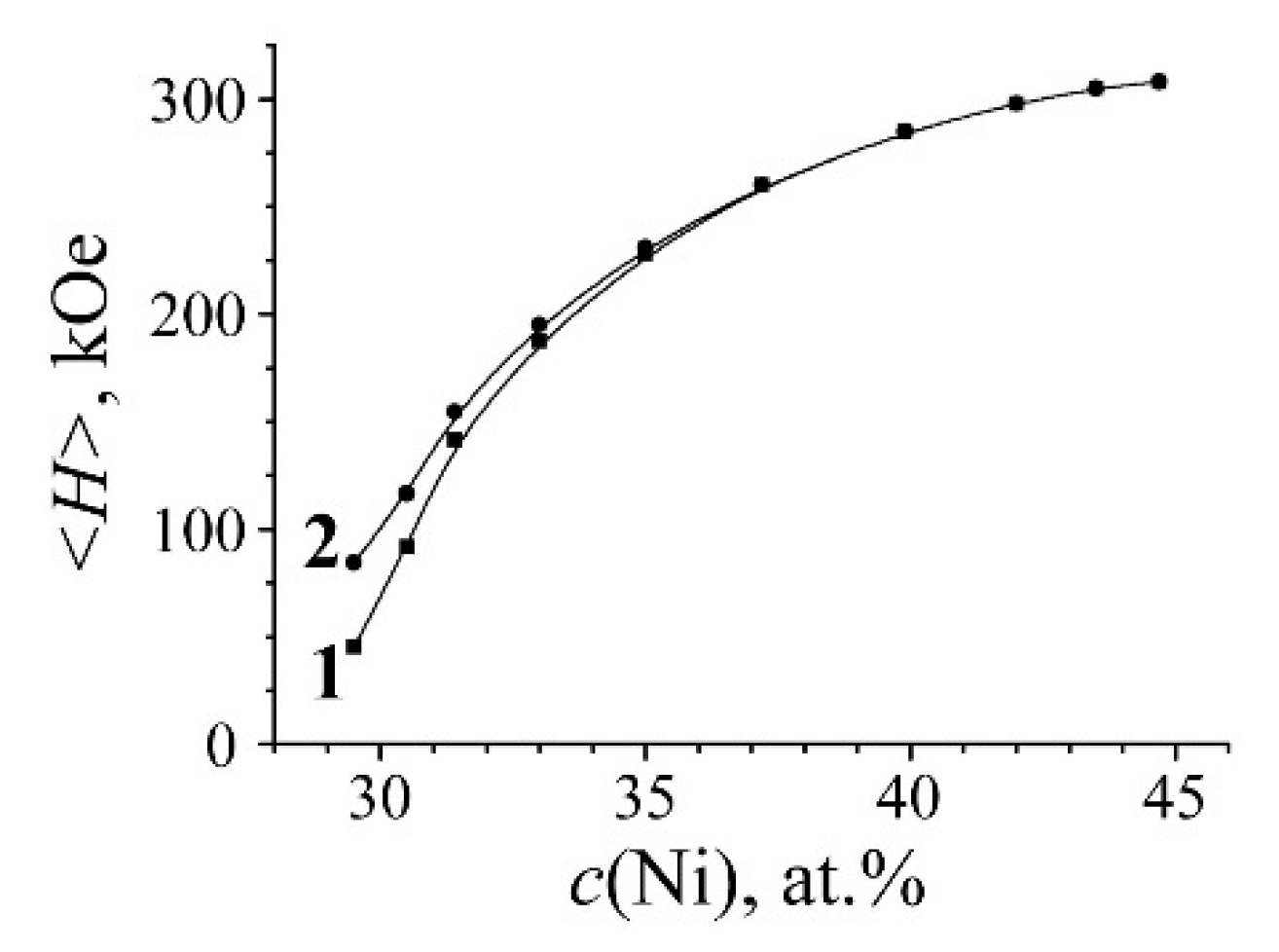

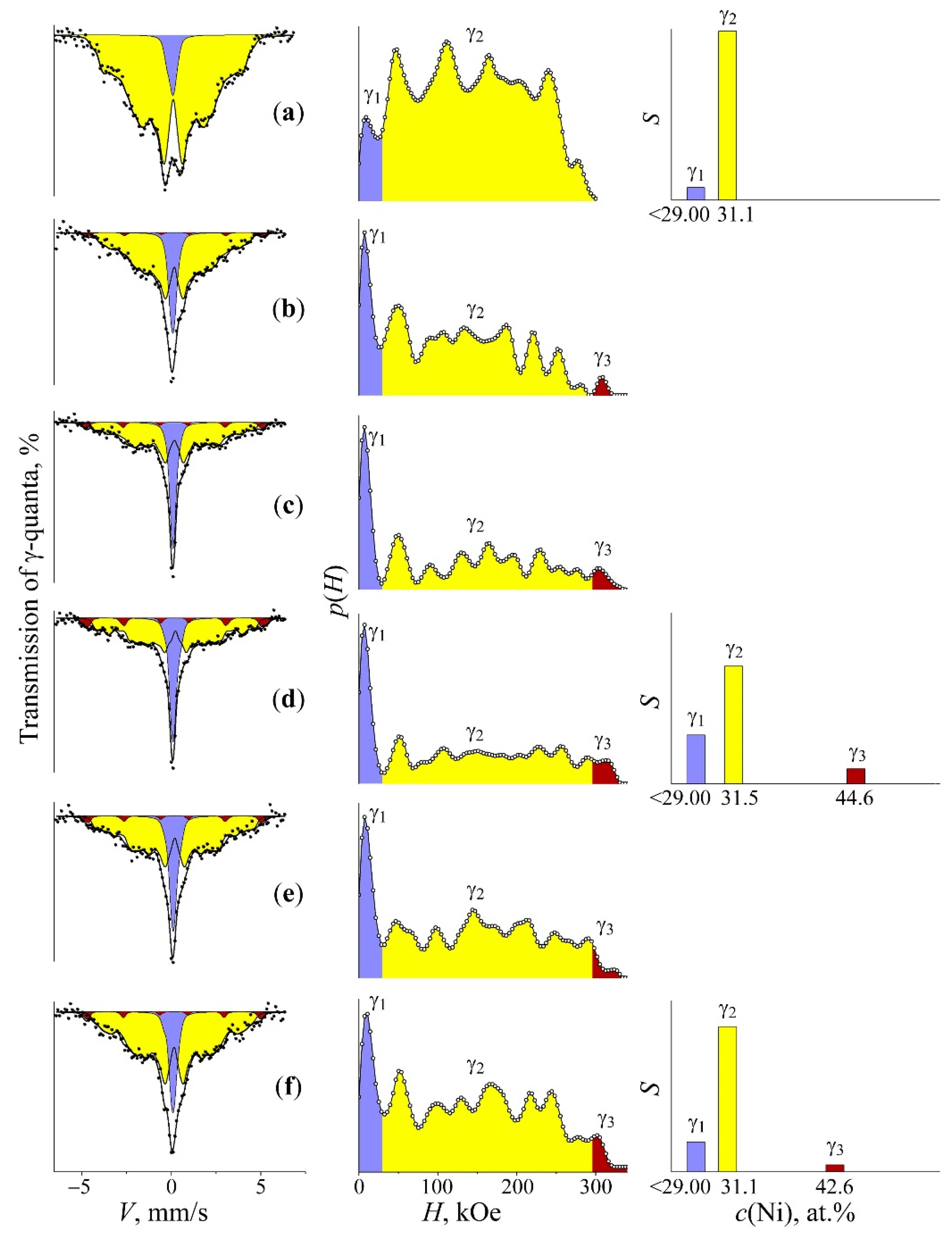
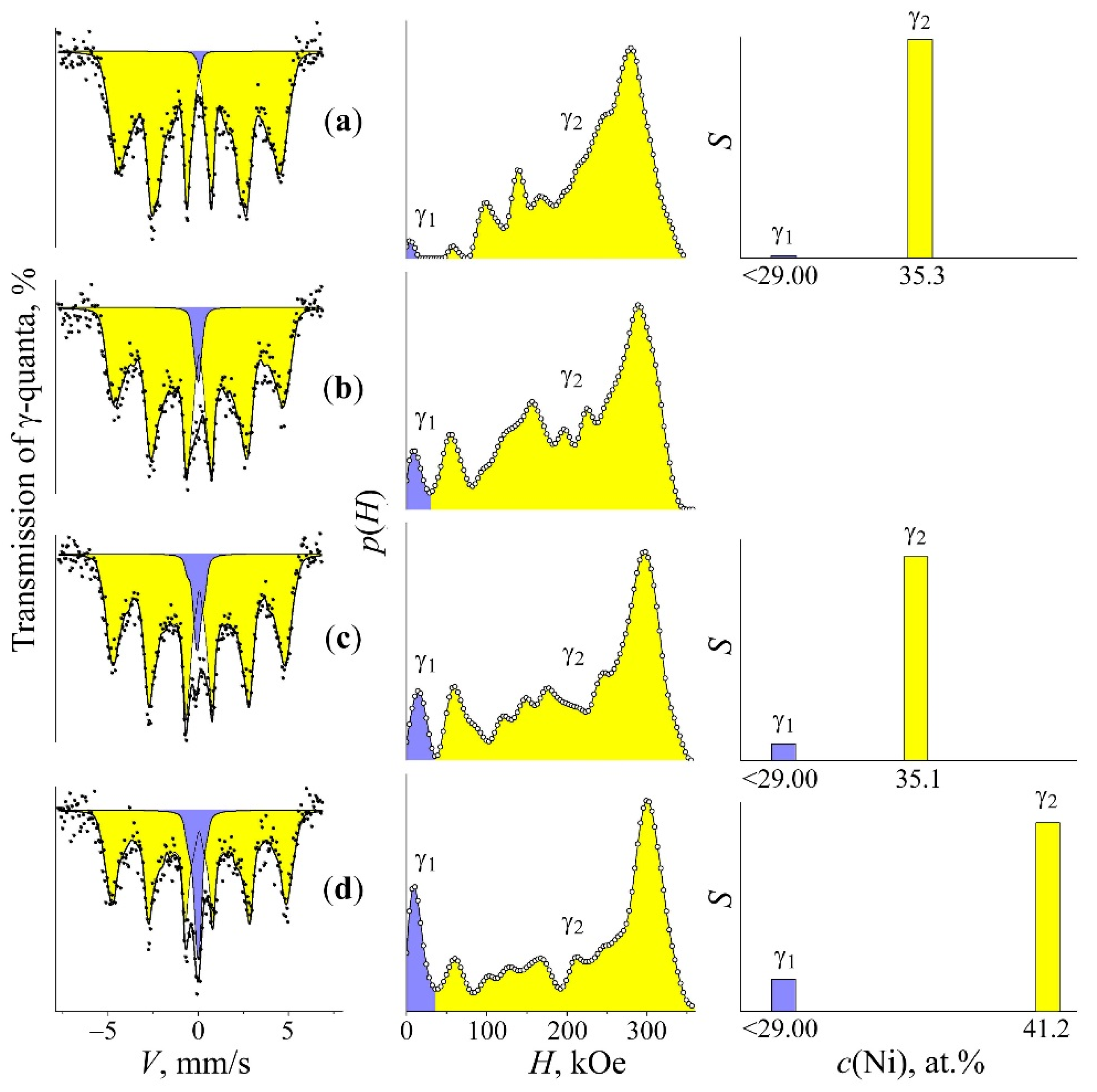
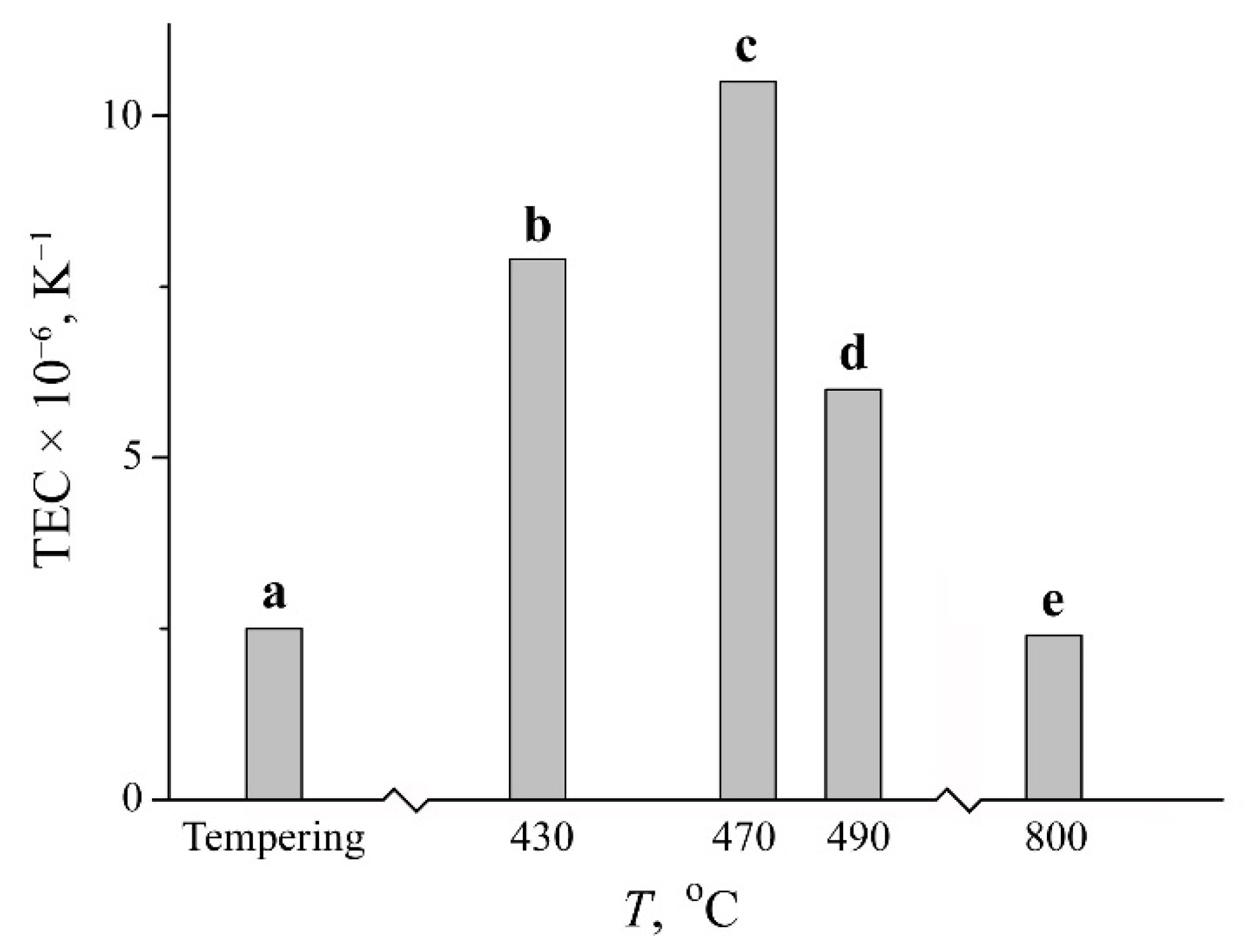
| № | Heating Temperature T, °C | α-Phase | γ1-Phase | γ2-Phase | ||
|---|---|---|---|---|---|---|
| <H>α, kOe (±1) | Sα, % (±5) | Sγ, % (±2) | <H>γ, kOe (±5) | Sγ, % (±5) | ||
| a | 20 °C | 331 | 64 | 4 | 144 | 32 |
| b | 400 °C | 335 | 58 | 4 | 160 | 38 |
| c | 470 °C | 337 | 47 | 3 | 184 | 50 |
| d | 490 °C | 340 | 23 | 12 | 204 | 65 |
| e | 520 °C | 344 | 1 | 21 | 166 | 78 |
| № | Heating Temperature T, °C | γ1-Phase | γ2-Phase | γ3-Phase | ||||
|---|---|---|---|---|---|---|---|---|
| Sγ, % (±2) | <H>γ, kOe (±5) | c(Ni)*, at.% (±0.1) | Sγ, % (±3) | <H>γ, kOe (±3) | c(Ni)*, at.% (±0.1) | Sγ, % (±1) | ||
| a | 20 °C | 7 | 144 | 31.1 | 93 | – | – | 0 |
| b | 400 °C | 19 | 140 | 31.0 | 77 | 308 | 44.6 | 4 |
| c | 450 °C | 27 | 147 | 31.3 | 64 | 306 | 43.8 | 9 |
| d | 470 °C | 27 | 159 | 31.5 | 60 | 308 | 44.6 | 13 |
| e | 490 °C | 20 | 150 | 31.3 | 71 | 304 | 43.2 | 9 |
| f | 520 °C | 16 | 145 | 31.1 | 75 | 301 | 42.6 | 9 |
Publisher’s Note: MDPI stays neutral with regard to jurisdictional claims in published maps and institutional affiliations. |
© 2022 by the authors. Licensee MDPI, Basel, Switzerland. This article is an open access article distributed under the terms and conditions of the Creative Commons Attribution (CC BY) license (https://creativecommons.org/licenses/by/4.0/).
Share and Cite
Shabashov, V.; Sagaradze, V.; Zamatovskii, A.; Kozlov, K.; Kataeva, N.; Danilov, S. Regulation of the Concentration Heterogeneity and Thermal Expansion Coefficient in the Metastable Invar FeNi31.1 Alloy. Materials 2022, 15, 8627. https://doi.org/10.3390/ma15238627
Shabashov V, Sagaradze V, Zamatovskii A, Kozlov K, Kataeva N, Danilov S. Regulation of the Concentration Heterogeneity and Thermal Expansion Coefficient in the Metastable Invar FeNi31.1 Alloy. Materials. 2022; 15(23):8627. https://doi.org/10.3390/ma15238627
Chicago/Turabian StyleShabashov, Valery, Victor Sagaradze, Andrey Zamatovskii, Kirill Kozlov, Natalya Kataeva, and Sergey Danilov. 2022. "Regulation of the Concentration Heterogeneity and Thermal Expansion Coefficient in the Metastable Invar FeNi31.1 Alloy" Materials 15, no. 23: 8627. https://doi.org/10.3390/ma15238627
APA StyleShabashov, V., Sagaradze, V., Zamatovskii, A., Kozlov, K., Kataeva, N., & Danilov, S. (2022). Regulation of the Concentration Heterogeneity and Thermal Expansion Coefficient in the Metastable Invar FeNi31.1 Alloy. Materials, 15(23), 8627. https://doi.org/10.3390/ma15238627








